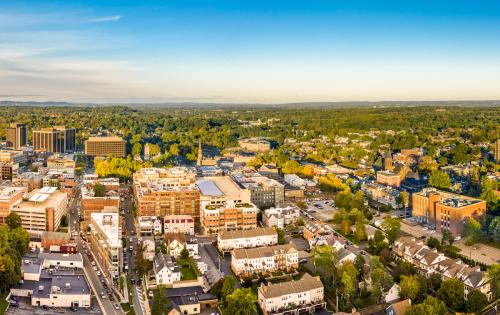The Bureau of Labor Statistics (BLS) employment report released today shows that 103,000 jobs were gained in March. In this blog post, I report results from three alternative projections, each of which was calculated using methodology outlined in my past research. Applying a more stable seasonal adjustment to the raw data, and accounting for the effects of weather on employment yields 124,000 jobs, which is 21,000 above the BLS Official number.
Calculating the Alternative Seasonal Adjustment
Monthly job gains and losses can indicate how the economy is doing once they are corrected to account for the pattern the BLS already expects in a process called seasonal adjustment. The approach for this seasonal adjustment that is presently used by the BLS puts very heavy weight on the current and last two years of data in assessing what are the typical patterns for each month.
In my 2013 paper “Unseasonal Seasonals?” I argue that a longer window should be used to estimate seasonal effects. I find that using a different seasonal filter, known as the 3×9 filter, produces better results and more accurate forecasts by emphasizing more years of data. The 3×9 filter spreads weight over the most recent six years in estimating seasonal patterns, which makes them more stable over time than the current BLS seasonal adjustment method.
To produce the Alternative Seasonal Adjustment, I calculate the month-over-month change in total nonfarm payrolls, seasonally adjusted by the 3×9 filter, for the most recent month, which you can see in table below. The corresponding data as published by the BLS are shown for comparison purposes. According to the Alternative Seasonal Adjustment, the economy added only 71,000 jobs in March, 32,000 below the official BLS total of 103,000. As the March data were soft, the standard seasonal adjustment procedure will have revised the seasonal factors down. The alternative adjustment does not do this so much, and so the seasonally adjusted data are even weaker.
Calculating the Seasonal and Weather Adjustment
In addition to seasonal effects, abnormal weather can also affect month-to-month fluctuations in job growth. In my 2015 paper with Michael Boldin “Weather-Adjusting Economic Data,” we implement a statistical methodology for adjusting employment data for the effects of deviations in weather from seasonal norms. This is distinct from seasonal adjustment, which only controls for the normal variation in weather across the year. We use several indicators of weather, including temperature and snowfall.
Temperatures in March were about ½°C colder than historical averages, but somewhat snowier than normal: four Nor’easters battered the East Coast in a span of three weeks, two of which (Quinn and Skylar) registered as “notable” or “significant” on the Regional Snowfall Index. We calculate a non-trivial weather effect of –41,000 jobs. Thus, the Seasonal and Weather Adjusted estimate for March is higher than the BLS Official number, at 144,000. This is the time of year when weather effects in employment data tend to be largest; and this estimated weather effect is meaningful, but not especially large.
Combining the Alternative Seasonal and Weather Adjustments
The Alternative Seasonal Adjustment shows lower employment gains than the BLS Official number, but the Seasonal and Weather Adjustment show higher gains. One can indeed do the two adjustments jointly—both adjusting for weather effects and using a longer window. This is shown in the far-right column of the table labeled Combined Alternative Seasonal and Weather Adjustment. Making both adjustments, the employment change in March was an increase of 124,000 jobs, which is 21,000 above the BLS Official number.
Overall, the March number was notably weaker than the recent trend. Part of this owes to somewhat poor weather, but even after adjusting for this, it represents a slowdown in the pace of employment growth. Still, monthly data are very noisy, and the average for the first quarter is a bit over 200,000 new jobs per month, which is quite strong. It is a pace of jobs growth that is driving prime age participation back up, and should continue to do so. But even with some rebound in labor force participation, if this pace of jobs growth were to continue for another year or two, it would necessarily push unemployment to very low levels.
| Thousands of jobs added | BLS Official | Alternative Seasonal Adjustment[1] | Seasonal and Weather Adjustment[2] | Weather Effect[3] | Combined Alternative Seasonal and Weather Adjustment[4] |
|---|---|---|---|---|---|
| 2018-March | 103 | 71 | 144 | -41 | 126 |
| 2018-February | 326 | 352 | 320 | +6 | 348 |
| 2018-January | 176 | 182 | 164 | +12 | 168 |
| 2017-December | 175 | 169 | 191 | -16 | 155 |
| 2017-November | 216 | 246 | 229 | -13 | 262 |
| 2017-October | 271 | 249 | 264 | +7 | 262 |
| 2017-September | 14 | 15 | 10 | +4 | -15 |
| 2017-August | 221 | 231 | 234 | -13 | 249 |
| 2017-July | 190 | 206 | 175 | +15 | 196 |
| 2017-June | 239 | 245 | 242 | -3 | 254 |
| 2017-May | 155 | 136 | 179 | -24 | 162 |
| 2017-April | 175 | 156 | 130 | +45 | 115 |
| 2017-March | 73 | 41 | 122 | -49 | 104 |
Note: Changes in previous months’ numbers reflect revisions to the underlying data.
[1] Applies a longer window estimate of seasonal effects (see Wright 2013).
[2] Includes seasonal and weather adjustments, where seasonal adjustments are estimated using the BLS window specifications (see Boldin & Wright 2015).
[3] BLS Official number less the Seasonal and Weather Adjustment number.
[4] Includes seasonal and weather adjustments, where seasonal adjustments are estimated using a longer window estimate.
The author did not receive financial support from any firm or person for this article or from any firm or person with a financial or political interest in this article. He is currently not an officer, director, or board member of any organization with an interest in this article.






Commentary
March Nor’easters slow employment growth
April 6, 2018